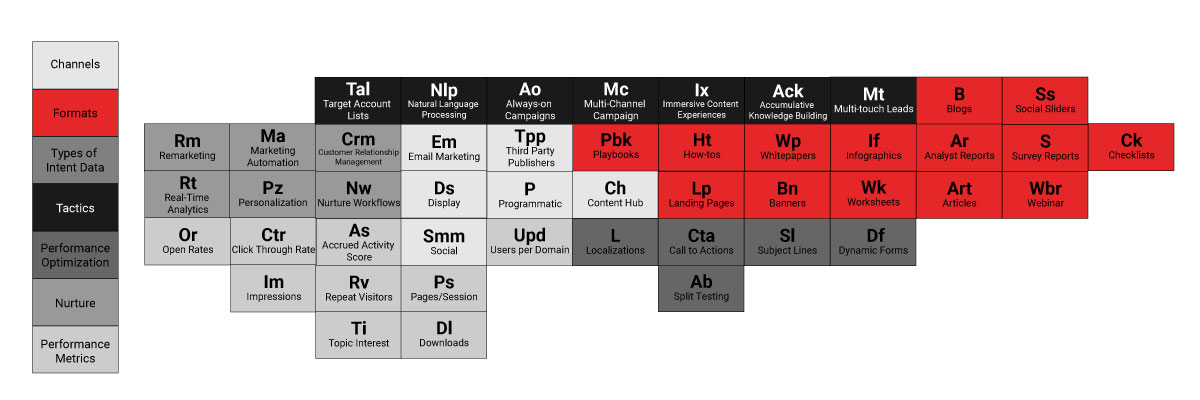Is B2B Content Strategy becoming an advanced artform?
The fundamental elements of B2B content marketing never change but they do evolve to enable cutting edge execution.
As part of our series on B2B content marketing strategy, we’ve created our own periodic table of essential content elements. This article goes one further with 3 techniques for ramifying basic content compounds into advanced B2B content marketing practices. Great for sense checking your current approach and keeping your campaign teams on track.
Reading time: 4 mins

Basic B2B Content Compound for: Brand Awareness

According to our research, 72.5% of B2B Marketers are not leveraging programmatic advertising as a core tactic this year, while 45% of companies leverage only one source of intent data.
This suggests many brand awareness campaigns will share similar characteristics to our basic model, combining basic elements into a core content compound.
From this model we can see there is a range of content formats aimed at serving top of the funnel activity. While this arrangement of content elements has proven to work in the past, we can see the inclusion of only one intent data element, in this case ‘searching’, along with the missed opportunity to reach an audience outside of own properties, through programmatic, immediately stunts available reach and misses opportunities to capitalize on available targeting capabilities to maximize cut through.
This helps us identify where ROI may take a hit if we don’t update our approach.
Acting on this knowledge, here is an example of how to apply new elements to up scale your approach:

Key areas our refreshed B2B content compound addresses:
Different forms of intent
We’ve expanded out of just one form of intent to embrace the key advantages the likes of Browsing, Firmographic, Action and Predictive offer. For a full break down of these intent data types check out 5 Different Forms of Intent.
Maximizing the amount of data points at your disposal will effectively help you transform accurate audience knowledge into precision led brand awareness campaigns that ultimately yield better ROI because they target the right in-market accounts. This is greatly enhanced by the inclusion of first and third party data elements, also included in our updated illustration.
Expanding targeting capabilities
In our advanced content compound you will see the inclusion of Natural Language Processing (NLP). The ability to locate companies with the highest propensity to buy, is an artform the right application of NLP brings you one step closer to.
By taking your target account list and leveraging NLP to match lookalikes based on this list, both reach and relevancy increase tenfold.
Programmatic
The adoption of programmatic in B2B has steadily been on the incline, however, as our survey results suggest, it’s still not garnered as much significance in the B2B marketing toolkit as we would have expected.
This is great news for advanced B2B marketing players as it provides a relatively accessible means of gaining competitive advantage. How? While brand awareness has often been assocaiated with woolly practice, programmatic brings to the table data-driven capabilities to drive precise messaging to tightly defined audiences, at their most receptive.
Remarketing
Remarketing techniques provides B2B marketers a second chance to drive brand value through a multi-pronged approach.
Through resurfacing your message, or even better, evolving awareness through serving a sequence of tailored messaging, remarketing is now a must for any serious brand awareness strategies.
It’s also an essential component for strategies aiming to immerse their audience through leveraging multi-channel tactics.
Basic B2B Content Compound for: Thought Leadership

Out of all our content compounds, thought leadership appears to have evolved the least, however, do not be deceived. The addition of channels Content Hub and Third Party Publishers, can have a huge impact on the success of your thought leadership programs.

Third Party Publishers
44% of the B2B marketers we surveyed say third party platforms are an effective channel. This means leveraging them can put you at an advantage over 56% of other marketers who are yet to acknowledge their potential.
Moving beyond your owned channels is a long standing trend that looks set to stay. Enabling you to expand your reach and tap into an established audience that meets your targeting criteria, third party platforms are a key tactic in fast tracking authority and brand credibility.
Content Hub
Leveraging a centralized hub to not only host all your most valuable content but also capture real-time engagement, is an unmissable opportunity to drive competitive edge. Building your hub around a key topic area that aligns with your core offering is a highly efficient way of building awareness and brand uplift through delivering premium content experiences.
The inclusion of these 2 additional channels means you can extend your performance metrics to provide a constant feed of audience intelligence. This can increase the value extracted from your data which can then be acted upon through continuously monitoring and improving your thought leadership strategy.
Basic B2B Content Compound for: Lead Generation

Lead acquisition is timeless but relying on a single channel and content asset to facilitate single-touch leads is dated. Content syndication has diversified in order to accommodate new multi-faceted approaches to lead generation. But not every marketer has adapted their approach.
In fact, our survey discovered multi-channel content distribution is a tactic for only 28% of B2B Marketers this year.
While efforts have been focused on actioning tighter targeting strategies, such as intelligence led target account lists (TALs) and ABM practices, less energy has been directed towards content and channels tactics.
This presents an opportunity to gain competitive advantage through reassessing your existing lead generation model and implementing additional tactics to bring it up to scratch.
Here is one example of how to expand your content marketing elements to embrace multi-channel and content elements.

Channels
As you can see, the channel elements cross over with our previous brand awareness content compound with the inclusion of elements such as programmatic. This marks how the boundary between brand awareness and lead generation is being traversed in favor of integrated campaigns working off a more holistic agenda.
Joint up thinking often results in more seamless and immersive content experiences that mindfully weave data points to propel audiences deeper into the brand. This is evident in the appearance of multi-campaigns, multi-touch leads and always-on campaigns in the above model, along with the shifting CPL model now factoring in impressions.
The addition of a content hub has enabled us to incorporate elements that encourage, capture and act on audience behavior such as accumulative knowledge building, real-time analytics and nurture workflows. While third party publishers enables greater interrogation over metrics such as topic interest.
Content Formats
When comparing the basic lead gen compound with our updated one, you can see the amount of content formats has significantly increased. While this is by no means an exhaustible list of assets, it gives you an insight into the diverse range of content needed to fuel the lead generation machine with its expanded channel elements.
You will also notice the inclusion of performance optimization elements such as localizations and split testing. These elements demonstrate the need to consistently monitor and adapt your content to suit the information needs of your audience – in the same personalization is included in the nurture elements. All these extra elements help to boost audience relevancy which ultimately build quality content experiences that drive superior value and long-term engagement.
Final thought
While our article has looked at some key techniques for advancing your B2B content marketing, they are not definitive. In order to sustain competitive advantage, perhaps what’s needed the most is an agile approach with the ability to adopt and evolve the key content marketing elements into the most efficient content compounds for your unique audience and business needs.
For more insights on how to advance your B2B content marketing strategy, check our latest resource.








